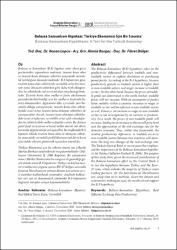Balassa Samuelson Hipotezi: Türkiye Ekonomisi İçin Bir Sınama
Abstract
Balassa ve Samuelson (B-S) hipotezi satın alma gücü paritesinden sapmaların nedenini, ticarete konu olan ve ticarete konu olmayan sektörler arasındaki verimlilik farklılığına dayandırmaktadır. B-S hipotezine göre, ticarete konu olan sektörlerde verimlilik artış hızı ticarete konu olmayan sektörlere göre daha hızlı olduğundan bu sektörlerde reel ücret artışları meydana gelmektedir. Ticarete konu olan malların fiyatı uluslararası piyasalarda belirlendiği için bu malların fiyatında bir artış olmayacaktır. İşgücünün ülke içerisinde tam hareketli olduğu varsayımıyla, ticarete konu olan sektörlerdeki ücret artışı ticarete konu olmayan sektörlere de yansıyacaktır. Ancak, ticarete konu olmayan sektörlerdeki ücret artışlarına, verimlilik artışı eşlik etmediğinden bu sektörlerdeki malların fiyatları artar. Bu durum genel fiyat seviyesinin artışına neden olarak reel döviz kurunda değerlenmeye yol açacaktır. Bu bağlamda B-S hipotezi ülkede ticarete konu olan ve olmayan sektörler arasındaki verimlilik farklılıklarının reel döviz kuru üzerindeki etkisini göstermek açısından önemlidir.
Türkiye Ekonomisi için bu etkinin önemi son yıllarda Merkez Bankası tarafından da vurgulanmaktadır (Enflasyon Görünümü II, 2006 Raporu). Bu çalışmanın amacı Merkez Bankasının bu vurgusu ile güncelliği göreli olarak artan B-S hipotezini Türkiye ve başlıca ticaret ortaklarının çoğunu içeren EU-27 bölgesi arasında finansal liberalizasyon sonrası dönem için zaman serisi metotları kullanılarak sınamaktır. Analizde kullanılan veri seti ve ekonometrik yöntemler B-S hipotezini doğrular sonuçlar ortaya koymamaktadır. The Balassa-Samuelson (B-S) hypothesis relies on the productivity differential between tradable and non-tradable sectors to explain deviations in purchasing power parity. According to the B-S hypothesis, because productivity growth in tradable sectors is higher than in non-tradable sectors, real wages increase in tradable sectors. On the other hand, because the prices of tradable goods are determined in the world market, tradable prices will not increase. With an assumption of perfect labor mobility within a country, increases in wages in tradable sectors will be reflected in non-tradable sectors as well. However, an increase in wages in non- tradable sectors is not accompanied by an increase in productivity. As a result, the prices of non-tradable goods will increase, leading to an increase in the overall price level and the appreciation of the real exchange rate for the domestic economy. Thus, within this framework, the relative productivity differences in tradable vis-à-vis non- tradable sectors between two countries will determine the long-run changes of the real exchange rate. The Turkish Central Bank in recent years has emphasized the importance of the Balassa-Samuelson hypothesis for Turkey (Inflation Outlook II, 2006). The purpose of this study then, given the increased consideration of the Balassa-Samuelson effect by the Central Bank is to test the hypothesis between Turkey and the Euro-27 area, which includes the majority of Turkey’s main trading partners, for the post-financial liberalization era, using time series methods. Given the dataset and econometric techniques used, the results do not support the B-S hypothesis.
Source
Anadolu Üniversitesi Sosyal Bilimler DergisiCollections
- Cilt.12 Sayı.4 [12]


















